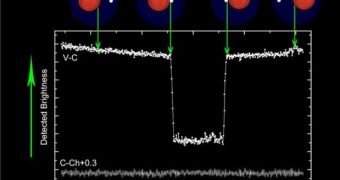Chinese astronomers have recently identified a new exoplanet, orbiting the peculiar binary star system known as QS Virginis. The thing about this giant planet is that it's about to be destroyed (and we use the word 'about' in its loosest form). The celestial body is orbiting two stars, rather than one, and the problem is that the latter will blow up in a massive nova outburst, one day in the future. This gigantic explosion will most likely ravage the exoplanet, or perhaps even destroy it completely.
In a scientific paper published in the latest issue of the respected journal Monthly Notices of the Royal Astronomical Society, Yunnan Observatory experts, led by Professor Shengbang Qian, reveal the exact state of the distant star system, which seems to be poised to blow. The space structure is not very far away from Sun. Specialists have estimated that the average distance between QS Virginis and the Sun is of about 157 light-years, in the direction of the Virgo Constellation. The two stars in the binary system are very close to each other, lying about 525,000 miles apart. Astronomers say that this is roughly twice the distance between the Earth and the Moon.
None of the stars is young. One of them is a cool, red dwarf, while the other is a very dense and hot, white dwarf. The short distance between them means that they exert impressive forces on each other. In fact, astronomers have inferred that they must be spinning around each other in less than three hours and 37 minutes. For reference, it takes about 365 days for our planet to spin around the Sun once. The close proximity also means that the individual components of the binary system cannot be made out using any telescopes. They were found to be separate by analyzing the brightness variations of the system, ScienceDaily reports.
The Chinese group explains that, as the two race around each other, they eclipse each others' light for short periods of time, which causes the shifts to appear. The variations are also strong enough to allow for them to be detected with the existing technology, the team also says. “For once we have advance notice of the formation of a cataclysmic variable and the chance to study what will happen to the planet in orbit around it. The scientific community should watch this system over the decades ahead – it should give us a real insight into these exotic stars,” Qian says. Observing what the nova explosion does to the exoplanet may yield more clues on planetary evolution.

 14 DAY TRIAL //
14 DAY TRIAL //